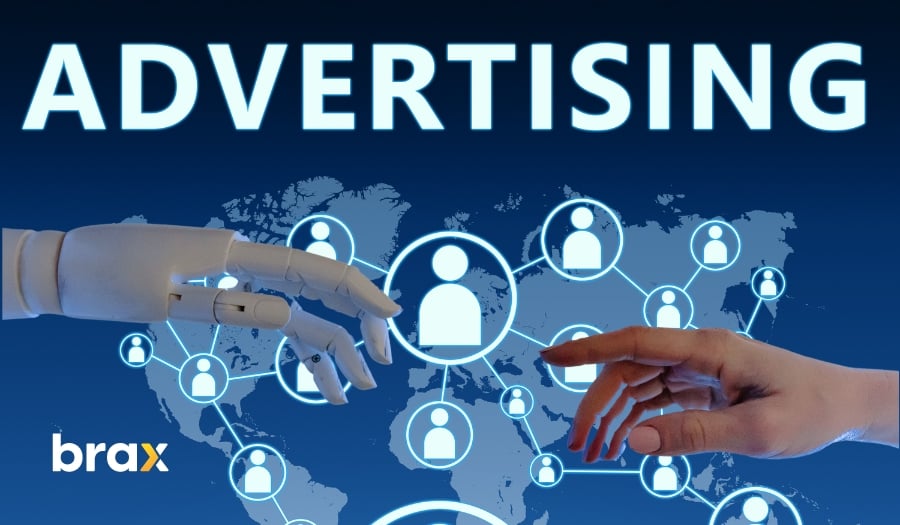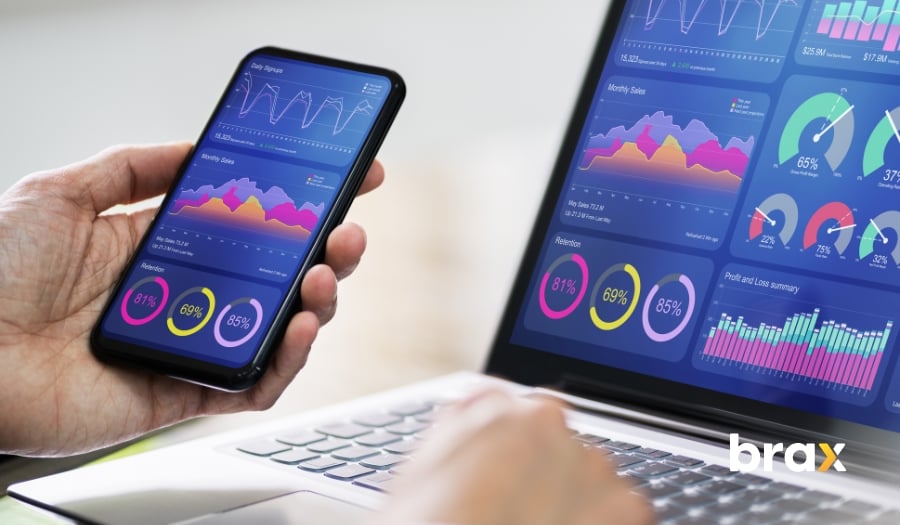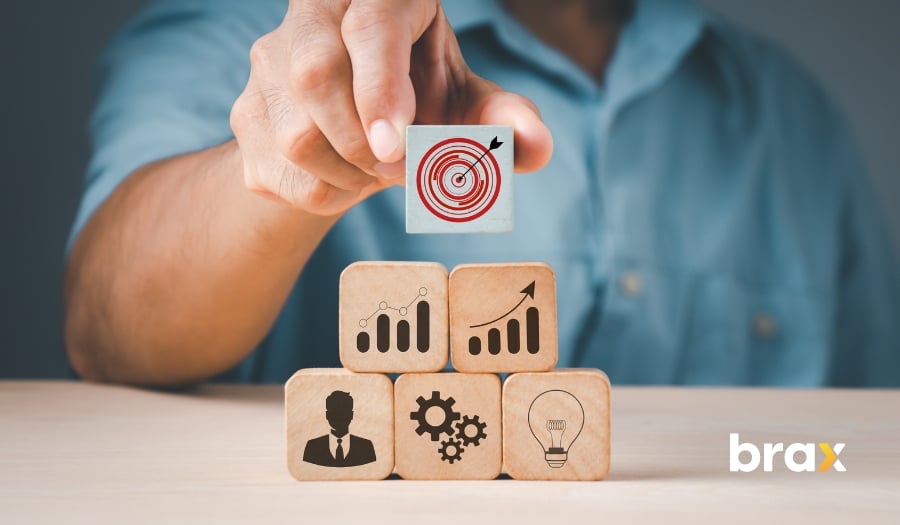Artificial intelligence is taking the world by storm and making headlines everywhere. You can hardly open a news website without seeing a new piece about AI. In the blink of an eye, machines have taken the wheel, and we are now firmly on the road to a future where life as we know it is transformed.

We've seen how it discerns faces and makes filters in social media (particularly TikTok), how it creates complete articles for websites, to how it generates visual art (though if it can be called art is still up for debate).
As AI unlocks new and exciting opportunities in the worlds of healthcare, business, and security, it will no doubt continue to weave its way into the fabric of our daily lives. But can it also be used for advertising? And if so, how what are its potential impacts on the advertising industry?
How is AI Used in Advertising?
Five years ago, an incredible event completely changed the advertising landscape: Lexus released their first-ever AI-scripted commercial! This groundbreaking ad was developed in partnership with IBM Watson and directed by Oscar-winning director Kevin Macdonald.
Using Watson's natural language processing AI technology, all the variables like locations, characters, and plot points were input into the system to generate the entire commercial. The outcome? An absolutely mesmerizing 60-second spot that left everyone wondering how it was even possible.
Watch it below:
This experiment has since had tremendous implications for the industry — opening up possibilities for faster ad campaigns with lower costs but higher quality. We can now use AI for market research too, making sure each message resonates with its intended audience.
It's mind-blowing what this innovative AI technology is capable of and where it could take us five more years from now!
What else can AI do when it comes to marketing and advertising?
Is creating an ad script the only way to use AI in advertising? Not really! Here are other ways:
Programmatic Media Buying
With the rise of digital advertising, the demand for more efficient and effective media buying has grown. Enter AI, the super-smart algorithm that's shaking up the advertising industry through programmatic media buying.
AI-powered systems can analyze massive amounts of data in milliseconds and make buying decisions in real-time (that's why it's sometimes used Real Time Bidding). Think of it as a digital auctioneer that's always on, always analyzing, and always making the best decisions for your ad spend.
By using artificial intelligence in programmatic media buying and real-time bidding, advertisers can reach their target audiences with much more precision than ever before. It's no wonder that AI is quickly becoming a staple in the media buying industry.
Advertisers can customize their campaigns based on a variety of factors, including target audience demographic, location, and more. These criteria are then used to bid for ads across various ad networks and exchanges. The bids that come in the highest will win the impression — allowing advertisers to reach the right people with their message at the right time.
Better Data Analysis
AI is changing the game for digital advertising — and savvy marketers are taking advantage of this powerful technology to drive sales and grow their businesses.
AI technology can crunch data in a matter of seconds, something that humans can also do but a thousand times slower. By leveraging AI's power, advertisers can quickly identify which strategies are working or not, providing deeper insights than ever before.
Instead of relying on guesswork, you can get real, actionable insights about your audience and their behaviors. Look at how Lexus utilized data analysis to craft a new ad for their car!

Enhance Targeting
AI in advertising is like a super-sleuth detective that can find your ideal customers with just a few clicks. Seriously, it's insane how accurate it is! With AI, companies can target specific audiences and demographics like never before. It's like having a laser pointer that finds exactly who you're looking for in a crowded room.
You see, AI has the power to analyze massive amounts of data on consumer behavior and preferences. It can track everything from the websites people visit to the products they buy and use that information to create detailed profiles of different types of consumers. With this data, AI algorithms can predict which ads will resonate most with each group of people and even identify new groups that companies might not have thought to target before.
Improve Campaigns through Machine Learning
This AI stuff is like having a mini-army of analysts and ad managers on your side all the time! With the help of this technology, advertisers can quickly identify what strategies are working and which aren't, providing insights that would have otherwise taken much longer for humans to find.
And what does it do with what it has analyzed? It can make decisions in the blink of an eye and automatically optimize campaigns for you.
Plus, when you’re bidding for ads across different native advertising publishers, artificial intelligence will ensure that your bid comes out on top based on the maximum bid that you set. That way, you get maximum reach with minimal effort, time, and money — now that's what I call a win-win situation!
Several native ads optimization tools have already been around for a few years now, including Brax! We at Brax can attest to how many businesses and marketers have been helped by automated optimization in reaching their audiences and getting better ROAS.
Personalization in Ads
Have you ever encountered an ad that speaks right to you, as if it already knows who you are and what you need? I'm sure you'd say yes. AI is at work there.
In today's age of information, the competition for consumers' attention is fierce. For advertisers, the key to success lies in targeting the right audience with the right message.
Enter artificial intelligence, which offers a solution by allowing companies to create hyper-personalized ads that speak directly to a particular user's interests and habits.
By analyzing consumer data — from search history and social media activity to purchasing behavior and more — AI algorithms can identify patterns and preferences that enable brands to tailor their messaging more effectively.
It's no surprise, then, that personalized ads outperform generic ones in nearly every measurable way. With the type of ad I mentioned above, it's possible you have clicked on it, which marks success for the advertiser.
As such, with AI-powered advertising, businesses are able to cut through the noise and connect with their ideal audience in a meaningful way.

If you're not using artificial intelligence for digital advertising, you might be losing your chance! The insights and data-driven decisions that AI can provide give you a major advantage over your competitors.
Think of it like having an extra set of eyes that helps you stay ahead of trends and optimize advertising campaigns with precision to capture market share faster. It's the key to staying ahead in today's ever-changing landscape and getting real value out of digital advertising investments.
The Downside to Using AI for Advertising
But life's not always sunny — and the same goes for using AI in advertising.
First, there are some ethical questions about the use of AI.
There is a concern that AI can overstep privacy boundaries by gathering customer data to target them with ads.
Additionally, some worry that AI-powered advertising targeting could lead to discrimination by profiling people who are already at a disadvantage or manipulating vulnerable people into buying products they don’t need or want. It raises questions around transparency and accountability – how can we ensure companies aren’t using biased data sets for their algorithms?
These ethical concerns need to be carefully considered by companies that use AI for advertising in order to protect both consumers as well as the industry itself from potential backlash.
A good starting point would be to provide clear guidelines on what data is acceptable and not acceptable for use when creating models. Also, having an ethics committee that is responsible for reviewing proposed algorithms prior to deployment would go a long way towards ensuring any potential ethical issues are addressed before they become a problem.
Second, AI relies on large data sets and algorithms, which can be difficult to debug or optimize if something goes wrong. Also, if the data set is too small, the predictions will not be accurate.
That's why it's important for marketers to have a good understanding of the fundamentals behind AI, so they can appropriately leverage it for their campaigns.
Also, AI lacks in-depth human understanding.
AI tools may not always accurately assess the success of specific advertising efforts due to a lack of understanding of human behavior. You might already understand why an ad works by looking at it, while AI does not — it only picks up the data.
Also, AI solutions cannot interpret subtle nuances in language or pick up on the hidden meaning behind words like humans can.
As it relies heavily on data and analytics, it could limit creative approaches to reaching potential customers because AI does not innately understand buying motivations or needs for certain products or services.

In short, while employing artificial intelligence in advertising can create better-targeted marketing campaigns and boost ROI, it lacks the depth of understanding that humans possess — something that will always be essential to truly effective advertising.
This means that even with AI, a human touch is still necessary for advertising strategies to work.
Benefits of Using AI for Native Advertising
Native advertising is a hot marketing type in the world of advertising. Think of it as a sneakily crafted piece of advertising that's strategically embedded into the content of a website, mobile app, or social media platform.
Unlike traditional advertising that can feel intrusive and forced upon consumers, native advertising aims to blend in seamlessly with its surroundings, giving it a more natural feel.
Now that we've enumerated some of the ways AI can be used for advertising in general let's talk about how AI can be used for Native Advertising.
1. Build Ad Creatives Quicker
In the world of advertising, speed is key. And with the rise of AI and automation, the possibilities for creative and efficient approaches have skyrocketed.
For native advertising specifically, these technologies can be utilized to build ad creatives more quickly than ever before.
Picture this: your team is brainstorming ideas, the AI algorithm suggests some killer themes, and with a few clicks, a fully-formed ad is ready for launch.
You can mix and match your own creatives with what the AI has produced and test them all. Yes — test. After all, even with AI around, there's no way to predict which ones will perform best until tested.
If you have your own ad copies, you can use AI-generated images to match your native ad. There are several image-generation tools available today — some are even free!
Not only does this save valuable time, but it allows for more experimentation and a higher likelihood of success.

2. Craft Dynamic Ads with Ease
Dynamic ads are those that change based on the information instantly gathered about the user. This can include details such as ISP, IP, location, the device being used, a bit of search history, and more.
If you have this data in your hands, you can make better ads, right? But you can't create personalized ads the moment the user views a webpage. This is where AI and automation shine best for native ads — they can make the decisions and changes for you in a split second.
All you need to do is implement a dynamic token that will collect info and change specific words or sections of your landing page or even your ad text.
By incorporating dynamic ads that are personalized to each user’s interests based on data and insights gathered through AI, advertisers can engage consumers with better messaging that’s custom-tailored to their preferences.
This approach can help native ads achieve better customer engagement rates (click-thrus for native ads), improve conversion rates, and ultimately, drive greater impact for brands.

3. Employ Rules-based Optimization
By utilizing Rule-based Optimization, AI can help optimize native advertising campaigns, ensuring maximum engagement and ROI.
But what exactly is Rule-based Optimization? Well, it's a system that uses predetermined rules to make decisions based on data.
In the case of native advertising, AI can use this system to analyze and adjust campaigns in real-time, making sure that non-performing ads, zones, and websites are paused (or at least have reduced bids) while good-perming ones are boosted even more.
We know that AI doesn't work without triggers, which means the optimization process still relies on what the advertiser wants.
Brax uses AI by optimizing campaigns based on specific criteria you set. In short, it automates what you would otherwise do manually, effectively eliminating the tedious task while making sure that your campaigns are up to par.
You can do this by setting up Rules. For more information on how to do this, refer to our guide on how to use rules to optimize your native ads.
4. Analyze Ads based on Custom Metrics
As the business world becomes increasingly sophisticated, tracking and measuring advertising effectiveness is more critical than ever. But not all metrics or data are created equal. While some companies have traditional key performance indicators (KPIs) that they track, others may have unique metrics that are not typically monitored.
With the help of AI, you can set these metrics up and analyze them without having to go through tiresome computations. You can then generate reports with ease — whether they be for personal use or for reporting to your boss or clients.
Here in Brax, you can create custom KPIs and conversion metrics based on your needs. This will allow you to measure and analyze the performance of your campaigns quickly and accurately. You can even set thresholds for notifications or alerts if a certain metric reaches a certain value.
If you'd like to see how Brax works in action, book a free demo today!
Bottom Line
Advertisers shouldn't be intimidated by artificial intelligence — it's here to stay, and it's only going to become more integral in the marketing world.
There are downsides to using it, including ethical questions and the lack of human touch. But still, AI allows marketers to create ads that they wouldn't be able to create in record time if done manually, thus saving time and money.
You really can't go wrong with AI in your toolkit — it's the way of the future! So don't be afraid to hop on board and start using AI to enhance your digital marketing efforts. The rewards will be worth it!

